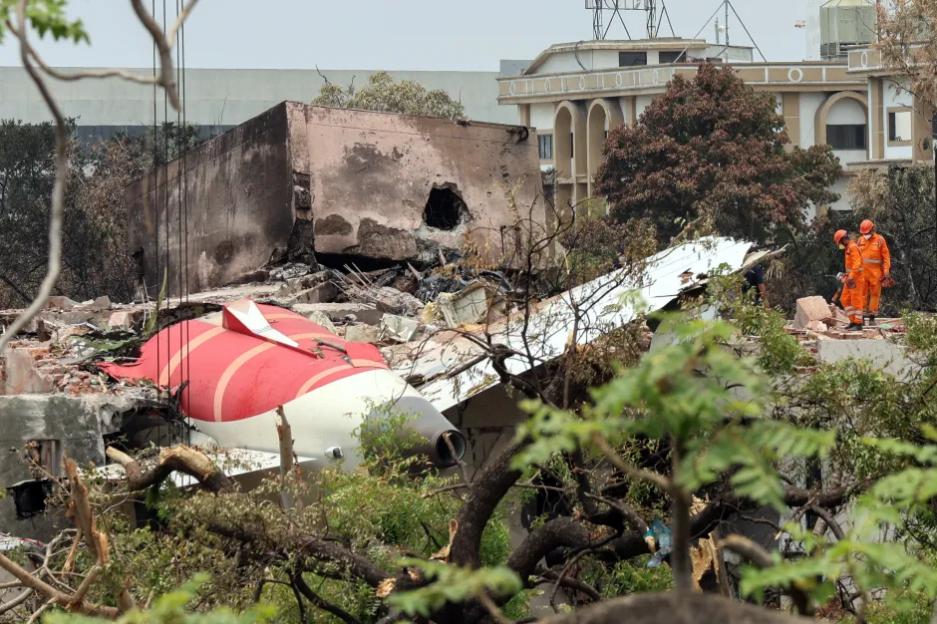CRASH investigators are said to be probing the medical records of the doomed Air India flight’s Captain amid claims he suffered from mental health problems.
Preliminary report into the fatal crash found thewhich led to a during the initial take-off.
 Captain Sumeet Sabharwal was the lead pilot in the doomed Air India flight
Captain Sumeet Sabharwal was the lead pilot in the doomed Air India flight Officials inspect the remains of the Air India passenger plane at the crash site near Sardar Vallabhbhai Patel International Airport in Ahmedabad
Officials inspect the remains of the Air India passenger plane at the crash site near Sardar Vallabhbhai Patel International Airport in Ahmedabad One of the rear landing gears amid debris at the site of a plane crash
One of the rear landing gears amid debris at the site of a plane crash The plane seconds before disaster
The plane seconds before disasterThe Air India flight bound to Gatwick was led by Captain Sumeet Sabharwal, who was reportedly just months away from retirement.
But the pilot had been considering leaving the airlines early to look after his elderly father, The Telegraph revealed.
A leading aviation expert in told the media outlet that CaptainSabharwal reportedly suffered from mental health issues and â and had taken time off in the last few years following his mum’s death.
Captain Mohan Ranganathan, a former instructor pilot of Boeing 737, said: “I have heard from several Air India pilots who told me he had some depression and mental health issues.
“He had taken time off from flying in the last three to four years.”;
Although Mr Ranganathan added that CaptainSabharwal “must have been medically cleared by the company [Air India] doctors”; before flying.
He is understood to have taken a Class I medical exam on September 5 last year.
Investigators are now said to be probing his medical records after the preliminary crash report indicated there may have been human error, although some aviation experts claim it is a case of deliberate action.
Sources said the black box analysis has so far been unable to rule out “improper, inadvertent or intentional”; action that caused them to be flipped.
Families of the victims who tragically died in the crash have .
They have dubbed the “biased”; and said it only appears to “blame the dead pilots”;.
The Airline Pilots’ Association of India (APAI) rejected the “tone and direction”; of the inquiry and said it came without sufficient evidence.
However, India’s Civil Aviation Minister Ram Mohan Naidu Kinjarapu said that investigators probed in a “mature, transparent”; way.
“This is a preliminary report. We want the final report to come in, so let us wait for it,”; he added.
Early findings in the 15-page report released by the Indian authorities indicate .
The fuel switches were then toggled to the “RUN”; position, and the engines appeared to be gatheringpower, but failed to stop the plane from decelerating.
Key findings of the report:
- Dual engine shutdownâ fuel cutoff switches moved from ‘RUN’ to ‘CUTOFF’
- Confusion between pilotsâ cockpit audio confirms one pilot asked ‘why did you cutoff’, the other replied ‘I didn’t’
- RAT deployedâ as seen in CCTV footage before the crash
- Engine relight attemptedâ fuel switches were found returned to the “RUN”; at crash site
- 32 seconds âthe time theaircraft was airborne before it crashed
- Thrust levers mismatchâ Thrust levers found at idle but black box data shows takeoff thrust was still engaged
- Fuel test passâ fuel was clean without any contamination
- Normal take-off set-upâ Flaps and landing gear correctly configured
- No bird activityâ clear skies, good visibility, light winds
- Pilot credentials clearâ both medically fit and rested
- No sabotage detectedâ although FAA alerted over a known fuel switch vulnerability not checked by Air India
- Aircraft loading âthe flight was within weight and balance limits
Analysis of the cockpit voice recording revealed that one of the pilots asked: “Why did you cut off?”;
To which the other pilot replied: “I didn’t.”;
Though the report does not identify which comments were made by the flight’s captain and which were made by the first officer.
Nor does it “identify the cause â whether it was crew error, mechanical malfunction, or electronic failure.”;
Flipping the switches to cut off almost immediately cuts the fuel supply to the engines.
It is most often used to turn engines off once a plane has arrived at its airport gate and in certain emergency situations, such as an engine fire.
But the inconclusive report, which came after 30 days of the crash, does not indicate that the flight encountered any such emergency situation.
 A cockpit view of a Boeing 787 Dreamliner aircraft shows the fuel switch; Annotations by The Sun Graphics
A cockpit view of a Boeing 787 Dreamliner aircraft shows the fuel switch; Annotations by The Sun Graphics Clive Kunder was the co-pilot on the doomed flight
Clive Kunder was the co-pilot on the doomed flight Rear end of the aircraft after it crashed into a medical hostel
Rear end of the aircraft after it crashed into a medical hostelIt is almost impossible to turn the switches off accidentally â they must be pulled up and locked before flipping â a safety design feature that was introduced decades ago.
Protective guards are further installed to minimise the risks â raising further questions as to why the fuel switches in the Air India flight were turned off.
The report points out that the US Federal Aviation Administration (FAA) in 2018 issued a Special Airworthiness Information Bulletin (SAIB) â highlighting that a few737 fuel control switches were installed with the locking feature disengaged.
But it was not deemed unsafe, and no Airworthiness Directive (AD) â a legally enforceable regulation to correct unsafe conditions in a product â was issued.
A similar switch design is used in Boeing 787-8 aircraft, including Air India’s VT-ANB Dreamliner in question.
The FAA and Boeing have now privately issued notifications that the fuel switch locks on Boeing planes are safe,according to four sources and a document seen by Reuters.
The report said Air India had said it had not carried out the FAA’s suggested inspections, as the FAA 2018 advisory was not a legal mandate.
But it also said maintenance records showed that the throttle control module, which includes the fuel switches, was replaced in 2019 and 2023 on the plane involved in the crash.
Experts have said a pilot would not be able to accidentally move the fuel switches.
“If they were moved because of a pilot, why?”; asked U.S. aviation safety expert Anthony Brickhouse.
The Boeing 787 Dreamliner with 242 passengers on board â including 53 Brits â smashed into a doctors’ hostel in Ahmedabad in the west of India.
The plane was headed towhen it crashed just seconds after take-off, killing all but one passenger.
 Landing gear of the Air India plane crashed directly on the BJ Medical College UG hostel mess
Landing gear of the Air India plane crashed directly on the BJ Medical College UG hostel mess Vishwash Ramesh, the sole survivor of the Air India crash, poses for the first time since the disaster
Vishwash Ramesh, the sole survivor of the Air India crash, poses for the first time since the disaster 







